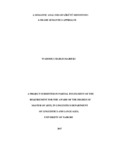| dc.contributor.author | Wahome, Charles K | |
| dc.date.accessioned | 2017-12-07T08:21:35Z | |
| dc.date.available | 2017-12-07T08:21:35Z | |
| dc.date.issued | 2017 | |
| dc.identifier.uri | http://hdl.handle.net/11295/101670 | |
| dc.description.abstract | This thesis investigates conceptual metonymy in Gĩkũyũ language within the Fillmore’s
frame semantic theory. Basically metonymy is a figure of speech where a concept or a thing
is referred to by the label of something closely related to that concept or thing. Metonymy
stands as an essential tool with which people comprehend their world and enhance their
language. Metonymy is a mode of reasoning applied extensively within people’s everyday
life. This study is based on three objectives, which are: to classify Gĩkũyũ metonymy, to
establish whether Gĩkũyũ metonymy is pervasive, and to ascertain whether Gĩkũyũ
metonymic expressions are systematic. The classification of the data was based on the
interpretation of Whole and Part as proposed by Radden and Kovecses (1999) and Kovecses
and Radden (1998) typology of ICMs, frames or domains. The analysis of the Gĩkũyũ
metonymy illustrate that metonymy is a cognitive means by which Gĩkũyũ speakers
conceptualize their environment. It is a ubiquitous way of thinking used widely by the
Gĩkũyũ language speakers as their way of life. The Gĩkũyũ language speakers use natural
objects in their environment and the human body parts as the vehicles to comprehend the
concepts of other domains. Some of the metonymies are well-entrenched in the language that
they are barely noticeable. The classification of the Gĩkũyũ metonymy has shown possibility
of having marginal occurrences of the metonymic sub-frames resulting to ambiguity in the
borders between the sub-frames. The description of the various Gĩkũyũ metonymic frames
and sub-frames and their taxonomies occur in turn. The findings also reveal that Gĩkũyũ
metonymic concepts are systematic depending on the interaction of the society with its
physical environment. The metonymic concepts are structured and manifest in determinable
relationships. The Gĩkũyũ metonyms involve only one conceptual domain, as the label of one
entity is made use of to refer to another entity that is associated to it either by being copresent
or successive. The target concept and the contributing concept are mostly related to
each other in conceptual clusters referred to as frames. | en_US |
| dc.language.iso | en | en_US |
| dc.publisher | University of Nairobi | en_US |
| dc.rights | Attribution-NonCommercial-NoDerivs 3.0 United States | * |
| dc.rights.uri | http://creativecommons.org/licenses/by-nc-nd/3.0/us/ | * |
| dc.subject | A Semantic Analysis of Gikuyu Metonymy | en_US |
| dc.title | A Semantic Analysis of Gikuyu Metonymy: a Frame Semantics Approach | en_US |
| dc.type | Thesis | en_US |



